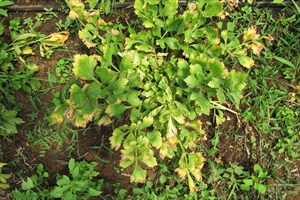Root knot nematode. General account of root knot nematodes (see Fact Sheet no. 127).
Pacific Pests, Pathogens, Weeds & Pesticides - Online edition
Pacific Pests, Pathogens, Weeds & Pesticides
Celery root knot nematode (254)
Meloidogyne species. Meloidogyne hapla, Meloidogyne incognita, and Meloidogyne javanica all attack celery.
Meloidogyne species are common on many crops throughout the tropics and sub-tropics. It has been recorded on celery from Samoa.
Apart from celery, common vegetable hosts are beans (Photo 1), capsicum, carrot, cucumber, eggplant, ginger, lettuce, potato, tomato (Photo 2), and yam; common fruit crop hosts are melon, papaya, and pineapple, and many ornamentals are also hosts.
Typical symptoms of nematode infestation of celery involve both leaves and roots. Infestation of the roots causes stunting, wilting, even when soil is moist, and yellowing of the leaves, characteristic of nutrient deficiency (Photos 3&4).
If nematode populations are high, seedlings or transplants may die, or remain stunted. If nematode populations are low, symptoms may develop later when there have been several cycles of nematode reproduction and roots have been damaged. Spherical galls occur on the roots, or extensive areas of swellings occur due to multiple infections (Photo 5). The fine lateral roots are destroyed.
After hatching from eggs, the young - called juveniles - invade roots near the root tip. Most are females as males are rare. Once inside the roots, the tissues enlarge, galls form, eggs are laid on the root surface, and they hatch to start the life cycle once more.
Spread over short distance occurs as the juveniles move in soil water in search of new roots to infect; over larger distances, spread occurs in the roots of seedlings, young plants or vegetative propagating materials. It is also possible for nematodes to spread in rainwater, and soil on tools, machinery or footwear.
On celery, the amount of damage to the roots and, therefore, the amount that yields are reduced, is related to two factors: (i) the levels of nematodes in the soil at planting, and (ii) the conditions under which the plants are growing. At very high populations, the nematodes may kill the plants, but this is rare. Plants growing in sandy soils are particularly susceptible.
Look for plants with yellowing leaves, and/or wilting, even though they have adequate nutrients and water. Look for plants with characteristic galls on the roots.
Ideally, soil samples should be taken to determine whether nematodes are present and in sufficient numbers to cause damage. Consult your agriculture authorities for methods of sampling and how to send samples to a laboratory for analysis. Usually, several samples are taken at depths of 15-25 cm, across a field, and kept separately in plastic bags. Be careful not to freeze samples, allow them to dry or leave them in direct sunlight.
If laboratory analysis is not available, select plants at random from across the field, shake out the soil, and estimate the level of galling - the size as well as the number of galls - as an indication of the nematode population.
Another, relatively simple, method can be used. Grow tomato seedlings in about 2 litre of the soil samples for a month, and check for root galls.
CULTURAL CONTROL
Before planting:
- Potting composts: in nurseries, use soil-less potting mix, or sterilised/pasteurised soil mixes.
- Soil solarisation: kill root-knot nematodes (plus other pathogens and weeds) in the top 30 cm of (especially sandy) soil by using transparent polyethylene covers. Moisten soil and cover for 4-6 weeks.
- Fallow land: keep soil bare for 4-6 months, but with frequent cultivation; make sure that weeds are controlled. The method exposes the nematodes to drying by the sun, and to starvation.
- Rotation: growing nonhost crops can reduce nematode populations, but there are several species of root knot nematodes and each has a very wide host range. Some grasses have been recommended for the Pacific islands [e.g., sorghum x Sudan grass hybrids (cv. Jumbo), and Green panic (a type of Guinea grass)]. Note, maize and peanuts are poor hosts of Meloidogyne incognita, and onions, cabbages and cauliflowers have tolerance.
- Grow marigolds: grow a solid planting of e.g., French marigolds for several months.
During growth:
- Soil amendments: Add manures or composts to the soil, especially to sandy soils, to increase ability of the soil to hold water and nutrients.
- Maintenance: Aim for optimum plant growth by frequent, deep watering, and adding mulches and organic matter.
After harvest:
- Collect the remains of the crop and burn it.
RESISTANT VARIETIES
There are no resistant varieties of celery available.
CHEMICAL CONTROL
A wide range of chemicals has been used for the control of root-knot nematodes, e.g., fumigants (methyl bromide, metham sodium, chloropicrin), liquids and granules (fenamiphos, oxamyl, furadan). Many of these are toxic chemicals that are now restricted or banned. Specialist advice is required to determined what, if any, chemicals are permissible for home or commercial use.
____________________
When using a pesticide, always wear protective clothing and follow the instructions on the product label, such as dosage, timing of application, and pre-harvest interval. Recommendations will vary with the crop and system of cultivation. Expert advice on the most appropriate pesticides to use should always be sought from local agricultural authorities.
AUTHOR Grahame Jackson
Information from (including Photo 2) Diseases of vegetable crops in Australia (2010). Editors, Denis Persley, et al. CSIRO Publishing. GrowVeg (undated) Celery root knot nematodes. (https://www.growveg.com.au/plant-diseases/uk-and-europe/celery-root-knot-nematodes/); and Westerdahl BB, et al. (undated) Celery Nematodes. University of California Statewide IPM Program. Agriculture and Natural Resources, University of California. (http://ipm.ucanr.edu/PMG/r104200111.html); and from Root-knot nematode (2017) Department of Agriculture and Fisheries. Queensland Government. Photo 1 Gerlach WWP (1988) Plant diseases of Western Samoa. Samoan German Crop Protection Project, Deutsche Gesellschaft für Technische Zusammenarbeit (GTZ) Gmbh, Germany.
Produced with support from the Australian Centre for International Agricultural Research under project PC/2010/090: Strengthening integrated crop management research in the Pacific Islands in support of sustainable intensification of high-value crop production, implemented by the University of Queensland and the Secretariat of the Pacific Community.








